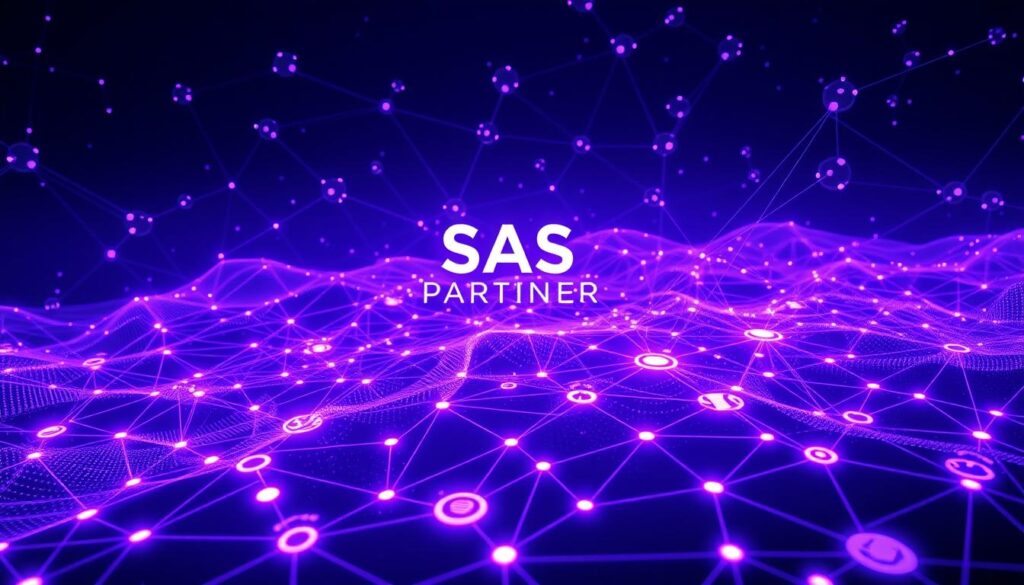A surprising 70% of SaaS companies say strategic partnerships are crucial for growth and innovation. Successful SaaS partner programs can lead to up to 15% market share growth in just one year. This shows how a well-designed SaaS partner ecosystem can greatly benefit a company’s bottom line.
By combining each partner’s strengths, businesses can offer a complete solution. This meets the changing needs of customers, boosting revenue and satisfaction.
Exploring SaaS partner ecosystems, it’s key to understand the role of software-as-a-service and cloud computing. These technologies help businesses grow their market, improve their products, and save costs. This makes a SaaS partner ecosystem a smart choice for companies wanting to stay competitive.
The advantages of a SaaS partner ecosystem are many. We’ll dive into how to build and manage a successful one in the next sections. For now, let’s look at the main points from our introduction to SaaS partner ecosystems.
Key Takeaways
- SaaS partner programs can significantly expand market reach and drive revenue growth
- Strategic partnerships are key to driving growth and innovation in the SaaS industry
- A well-designed SaaS partner ecosystem can result in up to 15% market share growth within the first year of implementation
- Software-as-a-service and cloud computing enable SaaS partner ecosystems
- Partnerships can lead to cost-effective growth and improved customer satisfaction
- SaaS companies with robust partner programs achieve twice the revenue growth compared to non-partnered counterparts
What is a SaaS Partner Ecosystem?

A SaaS partner ecosystem is a network of partners working together. They offer complementary products or services to customers. This digital ecosystem helps businesses grow, improve customer experience, and make more money.
At the core of this ecosystem are different types of partners. These include resellers, affiliates, and service partners. They team up to give customers a full solution. This is done through strategic partnerships that boost innovation and growth.
Key parts of a SaaS partner ecosystem are:
- Resellers, who sell a company’s products or services to end-users
- Affiliates, who promote a company’s products or services in exchange for a commission
- Service partners, who provide additional services to enhance the customer experience
By building a strong digital ecosystem through technology collaborations and strategic partnerships, businesses can stay ahead. They can drive innovation and achieve lasting success.
Benefits of a SaaS Partner Ecosystem

Businesses can grow by joining a SaaS partner ecosystem. They can reach more customers, improve their products, and save money. This is done through software integration, which makes different apps work together smoothly. Recent studies show that working together helps enter new markets and areas, making it easier to navigate.
Some main advantages of a SaaS partner ecosystem include:
- Happy customers and loyalty by adding services and products together
- Less risk by not relying on just one market or operation
- Quicker product launch and market entry with help from existing channels and marketing
Using platform alliances helps companies boost their marketing without spending more. This way, they can reach more people and work more efficiently. For example, Talkdesk has grown its customer base and improved its product by deeply integrating with Salesforce.
How to Choose the Right Partners

Choosing the right partners is key to a successful SaaS partner ecosystem. A good partner can expand your market, improve your product, and boost growth. In a software-as-a-service model, partners are crucial for delivering value to customers. To find the right partners, you need to know your business needs and check the skills of potential partners.
Identifying Your Business Needs
First, understand your business goals and target market. Know your ideal customer, their needs, and how your product meets those needs. In cloud computing, scalability and flexibility are important when picking partners.
Evaluating Partner Competencies
Look at a partner’s market presence, customer base, and what they offer. A partner with a strong market and complementary products can help you grow. For example, a company that offers accounting software could partner with one that provides payroll services. This creates a complete solution for customers.
Assessing Cultural Fit
It’s also important to check if your values and culture match your partners’. Shared values lead to better collaboration and more productive relationships. By choosing partners that share your vision, you can build a strong SaaS partner ecosystem. This ecosystem will drive growth and success for both parties.
Integrating Your SaaS Partner Ecosystem
To integrate your SaaS partner ecosystem well, you need collaborative processes. These help partners talk and work together smoothly. Use technology collaborations like APIs and data sharing platforms for this.
A good digital ecosystem means better products and services for customers. For instance, a customer service software company can team up with a chatbot tech firm. This partnership can boost revenue and make customers happier.
Integrating your SaaS partner ecosystem brings many benefits. Here are a few:
- Increased efficiency and productivity
- Improved customer satisfaction and retention
- Enhanced revenue growth and profitability
By focusing on technology collaborations and strategic partnerships, businesses can thrive. As we move forward in the SaaS partnership world, integration and teamwork are key to success.
Best Practices for Managing Partnerships
Managing partnerships well is key to a SaaS partner ecosystem’s success. It means setting up software integration steps, building collaborative networking, and making platform alliances that help everyone. This way, businesses can reach more customers, improve their products, and make more money.
A good partner program can grow your partner network and boost sales. For example, successful programs have clear partner roles, specific tools, and rewards for sales.
Some important ways to manage partnerships include:
- Regular communication and feedback
- Setting clear expectations and goals
- Establishing performance evaluation metrics
Using these methods, businesses can create lasting partnerships that help them grow and succeed.
The secret to great partnership management is to plan carefully and think long-term. This way, businesses can build strong, helpful relationships that grow together.
Case Studies of Successful SaaS Partner Ecosystems
Many industries, like tech and finance, have thriving SaaS partner ecosystems. These ecosystems combine software-as-a-service solutions with other services. This creates a full package for customers.
The cloud computing infrastructure is key. It makes data storage and processing scalable, secure, and efficient. This is vital for SaaS companies to grow through partnerships.
Example of Industry Leader 1
For example, an accounting software company can team up with a payroll service provider. Together, they offer a complete solution to their customers. This shows the strength of the SaaS partner ecosystem model.
Example of Industry Leader 2
Another example is a CRM software company partnering with a marketing automation tool provider. This partnership creates a smooth workflow for customers. It highlights the role of cloud computing in making these integrations possible.
What these examples teach us is crucial. Building strong relationships and setting clear expectations are key. Also, providing ongoing support and resources to partners is essential in a SaaS partner ecosystem.
Overcoming Challenges in SaaS Partnerships
To build a successful SaaS partner ecosystem, it’s key to tackle potential challenges. These include misaligned goals, conflicts, and market changes. By setting clear expectations and talking openly with partners, businesses can overcome these hurdles. This helps build a strong base for their digital ecosystem.
Good technology collaborations and strategic partnerships need careful planning. This means setting clear goals, checking if partners fit well, and assessing their skills. This way, both sides can win, and growth in the digital ecosystem can thrive.
Some key strategies for tackling SaaS partnership challenges include:
- Establishing clear expectations and communication channels
- Evaluating partner competencies and cultural fit
- Setting clear goals and performance metrics
- Fostering open communication and transparency
By using these strategies, businesses can forge strong, successful partnerships. These partnerships can boost growth and revenue. As the SaaS industry keeps evolving, staying ahead and adapting to new trends and customer needs is crucial.
Technology’s Role in Enabling SaaS Partnerships
Technology plays a big role in SaaS partnerships. Software integration is key. It makes different software work together smoothly. This means data can flow easily and tasks can be automated.
Collaborative networking tools help partners talk and work together better. This leads to stronger partnerships.
Platform alliances are also important. They let SaaS companies use other companies’ platforms and expertise. This helps them reach more customers, improve their services, and make more money. The benefits include:
- Increased market visibility
- Improved user experience
- Expanded market reach
- Enhanced credibility
Technology helps SaaS companies make better partnerships. These partnerships can grow and make more money. As the SaaS industry grows, we’ll see more tech helping partnerships succeed.
Measuring Success in a SaaS Partner Ecosystem
To see if a software-as-a-service partnership works, we need to track important signs. These signs include how much money is made, how many new customers are gained, and how happy those customers are. A good SaaS partner ecosystem uses cloud computing to share data easily and work together well.
Key Performance Indicators (KPIs)
- Partner-Sourced Revenue: Money made because of partner referrals or sales.
- Influenced Revenue: Money made where partners helped close the deal, even if they didn’t start it.
- Pipeline Value: The total worth of deals in the works because of partners.
Analyzing Returns on Investment (ROI)
It’s important to check the ROI often to make sure partnerships are worth it. Using cloud computing and software-as-a-service helps businesses work better and get a better ROI.
Feedback Loops and Continuous Improvement
Having feedback loops and always trying to get better helps find and fix problems. This way, businesses can make their strategies better, improve their partnerships, and grow more.
Future Trends in SaaS Partner Ecosystems
The SaaS market is set to hit $908.21 billion by 2030, growing at 18.7% annually. This growth comes from the need for cloud-based solutions and the role of tech partnerships. These partnerships help businesses innovate and stay competitive.
One trend is the rise of multi-cloud environments. More businesses are moving to a multi-cloud strategy. This requires partnerships that can manage different cloud platforms smoothly, improving the digital ecosystem.
Emerging tech like AI and blockchain is also changing SaaS ecosystems. They’re leading to more advanced and specialized solutions. This is pushing the growth of vertical SaaS solutions. As businesses look for specific solutions, the need for tech collaborations and partnerships will grow.
Some key stats show the future of SaaS:
- The SaaS market could reach $908.21 billion by 2030 at a CAGR of 18.7%.
- SaaS spending is expected to rise by 17.7%, reaching $232 billion in 2024.
- By 2027, SaaS revenue is forecasted to hit $344 billion, growing at 7.89% annually.
As the SaaS market evolves, tech collaborations, partnerships, and the digital ecosystem are key. Understanding these trends and adapting will help businesses succeed in the future.
Conclusion: The Power of Collaboration in SaaS
Collaboration is key for SaaS businesses to succeed. It helps them create solutions that meet customer needs. By teaming up, companies can reach more customers, improve their products, and save costs.
Good software integration is crucial in SaaS partnerships. It lets companies use each other’s strengths for better workflows. Collaborative networking is also important, sharing ideas and resources. Platform alliances open doors to new markets and technologies, boosting growth.
To start partnering, businesses must know what they need and who they should partner with. They should also check if they fit culturally. Clear goals, support for partners, and constant improvement are vital for success. Collaboration and integration lead to success in today’s fast market.
Looking ahead, collaboration will keep driving SaaS success. By teaming up, companies can innovate, grow, and stay competitive in a changing market.
Call to Action: Join the SaaS Partner Ecosystem Revolution
The SaaS partner ecosystem revolution is here. Businesses that join can get a big edge over others. Your SaaS company can get many benefits, like reaching more customers, improving products, and saving money.
How to Get Involved Today
To start, figure out what your business needs. Find partners that match your skills. Make sure they fit your company’s culture for better teamwork.
Set clear goals, offer support, and keep improving your partnerships. This will help you stay ahead.
Resources for Future Growth
Start your SaaS partner ecosystem journey with the help of many resources. Keep up with industry news and trends. This will help you adjust your plans and find new chances.
Look into tools for working together, sharing data, and managing APIs. These can make your partnerships smoother and help you innovate.
Stay Updated on Trends and Insights
The cloud computing world is always changing. It’s important to know the latest news. Read industry articles, go to events, and talk to experts.
This way, you’ll be ready for the SaaS partner ecosystem’s changes. You’ll be set up for success in the long run.

